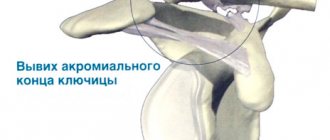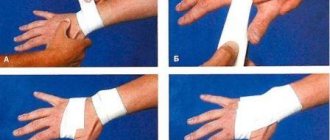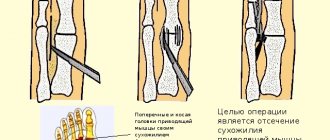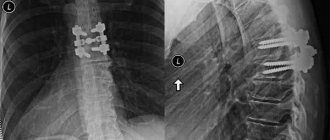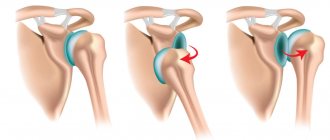A dislocated shoulder is an extremely dangerous injury. If the shoulder is not straightened, it will be impossible to move the limb, and the victim will experience severe pain. This joint is susceptible to dislocation due to its high mobility and large range of movements. Reduction must be carried out by a qualified specialist. But emergency cases arise when the injury needs to be corrected urgently, then you have to solve this problem yourself and set the joint back in place.
Causes and symptoms of dislocation
There are many factors that can cause shoulder dislocation, some of which include:
- falling from a height onto arms outstretched forward;
- motor vehicle injuries;
- blow to the shoulder area from the back;
- lifting weights.
In case of damage, a person feels severe acute pain and may hear a clicking sound. At the same moment, deformation appears at the site of the injury, the joint swells, the skin over it becomes hot to the touch, and sometimes bruises appear. Immediately after the injury, any movement in the joint becomes impossible. In addition, the dislocated shoulder is lower than it should be normally, and a dimple appears in the area of the brachialis muscle. The upper extremity may experience tingling, stiffness, and weakness. This indicates damage to the nerve plexus of the shoulder. If the arteries are damaged, the limb becomes very cold and turns blue. If a joint is dislocated, it is imperative to exclude a fracture of the patient's humerus.
Emergency medicine
In outpatient clinics, dislocations of the shoulder and fingers are usually reduced; the rest are treated in an inpatient setting. If the clinic does not have a traumatologist, then a surgeon provides assistance to such patients. Before reduction, 1-2 ml of a 2% solution of promedol is injected intramuscularly and local anesthesia is performed by introducing 30 ml of a 1% solution of novocaine into the joint cavity.
Reduction of shoulder dislocation according to Janelidze
The simplest and most effective method for reducing a dislocated shoulder according to Dzhanelidze. The patient is placed in a lateral position on a table, the edge of which should rest against the armpit (Fig. 81). The head is placed on another nearby table, bedside table or stand.
Rice. 81. Reduction of a dislocated shoulder using the Dzhanelidze method.
In this case, the dislocated limb hangs down between the tables. After 15 minutes, the full anesthetic effect of the injected novocaine is achieved, and the muscles of the shoulder girdle gradually relax. Then the doctor additionally pulls the hand by the forearm bent at a right angle and performs a rotational movement of the shoulder. A dislocation under such conditions is relatively easy to reduce. If pain relief is insufficient, muscle relaxation may not occur, which will make reduction difficult.
Reduction of shoulder dislocation according to Kocher
The Kocher method is complex and more traumatic; it should be used if reduction according to Dzhanelidze is impossible or unsuccessful. The patient is sitting. The assistant presses his shoulder girdle against the back of the chair with both hands. Without an assistant, it is convenient to reduce a dislocation with the patient lying down on the dressing table. The doctor takes the forearm of the upper limb bent at a right angle with both hands and brings the elbow joint to the body (Fig. 82, a). Then the forearm is moved to the side, rotating the shoulder and pulling it down (Fig. 82, b). The third technique is to move the elbow forward and upward without lifting it from the body (Fig. 82, c). Finally, without straightening the forearm, they vigorously bring it towards the body until the hand touches the healthy shoulder girdle, thereby rotating the shoulder inwards and reducing the dislocation (Fig. 82d).
Rice. 82. Reduction of shoulder dislocation according to Kocher. a, b, c, d — stages of reduction. Explanation in the text.
After reduction, to create rest for the joint, immobilization for 3 weeks is indicated in a posterior plaster splint with the forearm suspended on a scarf or bandage. A cotton-gauze roll is placed in the armpit. After 10 days, the splint is removed and physiotherapeutic procedures and physical therapy are prescribed. Working capacity is restored within a month, but patients need to be relieved from physical work for another month in order to prevent habitual dislocation.
Minor surgery. IN AND. Maslov, 1988.
Is it possible to straighten it at home yourself?
While waiting for an ambulance, you can try to reduce the pain with painkillers, ice and bandages.
If the procedure is performed incorrectly, the patient may lose consciousness from pain.
You can adjust your shoulder at home only in emergency situations, when qualified medical care is postponed until 12 hours after the injury. Otherwise, you need to wait for a qualified specialist. Consequently, when you are far from medical facilities, and also when the risk from an unreduced dislocation far exceeds the possible complications of its incorrect reduction, it is necessary to carry out this painful procedure yourself. If it is carried out correctly, the patient will not feel severe pain. If the reduction is performed incorrectly, the victim may develop the following complications:
- ruptures of muscles, ligaments and tendons that attach the joint;
- damage to nerve fibers and blood vessels;
- bleeding that poses a danger to the patient’s life;
- severe pain that can cause loss of consciousness.
What is the method for resetting a dislocated shoulder?
There are various ways to reduce a dislocated shoulder, the choice of which depends on the type of impairment. For a non-professional, the easiest method is when the victim lies on his back, and his upper limb is moved away from the body at a right angle, and you need to pull it sharply down. This movement will return the humeral head to the correct position. After reduction, the pain should decrease significantly, but the joint will remain unstable and there will be a possibility of re-dislocation, so it is necessary to make a bandage that will immobilize the joint.
Reduction method according to Dzhanelidze
Most often, doctors resort to the method of reducing the joint according to Dzhanelidze.
This method is used most often in orthopedics and surgery. Reduction of a shoulder dislocation according to Dzhanelidze must be carried out under local anesthesia. Procedure for manipulation:
- The patient is placed on the couch, and the limb is left hanging from it for 20 minutes.
- The doctor, facing the patient, holds him by the elbow and makes a rotational movement of the shoulder. Thanks to this, the joint returns to its natural place.
Reduction of dislocation according to Kocher
The method is used in the treatment of young people only. In patients with osteoporosis, the technique may cause complications. The victim takes a lying position on the couch and bends his arm at the elbow 90 degrees, fixing it in this position. Next, the doctor sharply turns the shoulder joint outward until it clicks. Upon completion of the Kocher shoulder reduction, the limb is fixed to the healthy arm in a curved and slightly elevated position using a bandage.
According to Hippocrates-Cooper
The essence of the method is that the patient lies on his back, and the doctor stands facing him and takes his hand with both hands. Then he rests his foot on the patient’s armpit in the area where the head of the bone is located. The doctor fixes it with his foot, and at the same time stretches the limb parallel to the person’s torso. It is important that the movements are coordinated and completely repeat the desired sequence, this will avoid serious complications of the Hippocratic shoulder reduction method.
Seminar on trace work. Kevin Kocher method.
Home \ Library \ Seminar on trace work. Kevin Kocher method.
“Mentrailing is easy!”
- Kevin Kocher, an American instructor of international level in training tracking dogs for police and rescue services, repeated this phrase throughout the training seminar on tracking work, which took place in St. Petersburg. But is this so, as an experienced handler with more than thirty years of experience says? And what is hidden behind the next foreign word “mentrailing”? The seminar participants, who came to the Northern capital from various cities of Russia, searched for answers to these and other questions for 4 days - from September 2 to 5. The author of the material was lucky enough to witness this unique event, before the reader - the result of my subjective observations, from which I tried to draw objective conclusions.
So, what is “mentrailing”? I will give a definition from the book by Kevin and his wife Robin, “How to Train Police Sniffer Dogs and Detective Patrol Dogs. Kocher Method: “Mentrailing is the pursuit of a person by a dog based on his individual scent. The difference between trailing dogs and tracking dogs is that a trailing dog naturally follows the individual scent of a person: it is not trained to walk with its head lowered to the ground and move strictly according to the prints of the person who has passed. In other words, the dog learns to follow the person's scent, but is allowed to do so instinctively rather than mechanically. This approach allows you to rely on the dog’s work in a wide range of terrain, including urban areas with predominantly asphalt or concrete surfaces”[1]. What is such a dog for? First of all, to search for lost or kidnapped children and elderly people. As a rule, such accidents occur in urban environments, where there are a lot of foreign odors. Tracking dogs rarely pick up a scent in such places, especially if it is cold and the sample of the desired scent is contaminated (let's be realistic - this is most often the case). Trailing dogs also get lost and don’t always find the scent, and this is normal, but Kocher’s method, described in detail in his book and partially voiced at the seminar, allows you to achieve success faster.
What trailing dogs learn:
- clearly pursue a person by individual scent;
- just follow the smell, and not look for it;
- inform the instructor that the desired smell is not present in the area under study.
Kevin goes into detail about the structure of the method and the building blocks that make it up in the book. But despite all the clarity of the information, some recommendations seem unclear or unnecessary. I became acquainted with excerpts from Kevin’s book and his diaries long before the seminar, and I must admit that I had doubts about the effectiveness of mentrailing. However, practical exercises and discussions of all the training “hot on the heels” not only dispelled my skepticism, but also proved that the technique works, and Kevin himself is a real professional, but it is very important to carry out all the recommended elements and not discard what seems like a trifle. The seminar participants were dog owners of different breeds with different levels of training and experience, most of them were volunteers, but progress in work by the end of the classes was obvious to everyone. The most obvious example is the training of a Belgian Shepherd puppy (Malinois, age - 4 months), who was introduced to the concept of “trace” directly at the seminar and in four days not only understood what they wanted from him, but also successfully completed most of the exercises. It is impossible to reveal all the secrets of the Kocher method in one article; I will only list what Kevin constantly focused the attention of listeners on:
- You need to start your first training in the city (on asphalt);
- the basis of all training and future success is in developing the dog’s motivation through regular training of an intensive track (one of the exercises of the Kocher method, see Chapter 10), and the complex of a standard intensive track, intensive from a scent sample and intensive with a delayed start is the backbone of everything training;
- The dog’s performance must be constantly maintained; for this, all components of the technique must be consistently reinforced;
- The dog should always have a high level of motivation, so it is very important that the work is, first of all, a fun game, and the reward is meaningful;
- the main mistake of beginners is excessive control of the dog with a leash and pushing on the scent; it is better to let the dog go in the wrong direction, let it make a mistake, and then make a correction, only in this way will it learn to make decisions independently and rely on its own olfactory capabilities;
- It is necessary to document everything you do during training;
- It will take more than one year to train a truly reliable working dog that will not let you down in real conditions (Kevin trains each dog for 3-4 years).
In addition to details related directly to the methodology itself, we also talked about the breeds that are most suitable for mentrailing. In fact, any dog can be trained for tracking work, since the instinct of pursuit is innate, however, as Kevin correctly noted, “you can also walk from Washington to New York, but it’s faster, and best of all, to get there by foot.” one of the Ferrari sports models,” and that “Ferrari model” for Kevin, his wife and many colleagues is the Bloodhound. Other hunting breeds also received positive reviews, including Beagles, which are of great interest to me. You should beware of those breeds that pursue prey using primarily their eyesight (greyhounds, for example), and any cowardly-aggressive individuals. I was also interested in whether Kevin uses any techniques for early stimulation of puppies and how to choose the most capable bloodhound in the litter? Kevin answered the first question in the negative, but answered the second as expected: “A puppy who loves to eat is my puppy! It’s always easier to work with food specialists...”
Conclusions: if you follow these and many other tips that Kevin generously shares in the book and even more generously shared at the seminar, if you train your dog regularly in different conditions and do this for several years (and ideally for a lifetime), if you choose the most suitable breed for this job, if you have the talent and enough observation and patience to learn how to read a dog, then that’s right - mentrailing is easy! And I really want many Russian professional rescuers and volunteers to be able to do this “simply.” PS The seminar was attended by representatives of the police of St. Petersburg, Arkhangelsk, Murmansk, rescuers of the Extremum ODS, Nadeya PSOkv and volunteers. I would like to wish all participants good luck and thank the entire Extremum team (Russia), Kevin Kocher (USA) and his colleague Karina Kalks (Austria) for organizing the seminar. Special thanks to Alexander Khaitin for his excellent work with Yandex and Snorri, beagles of our breeding!
Dina Neverova
[1] Kevin and Robin Kocher. “How to train police sniffer dogs and search patrol dogs. Kocher method", 2010
